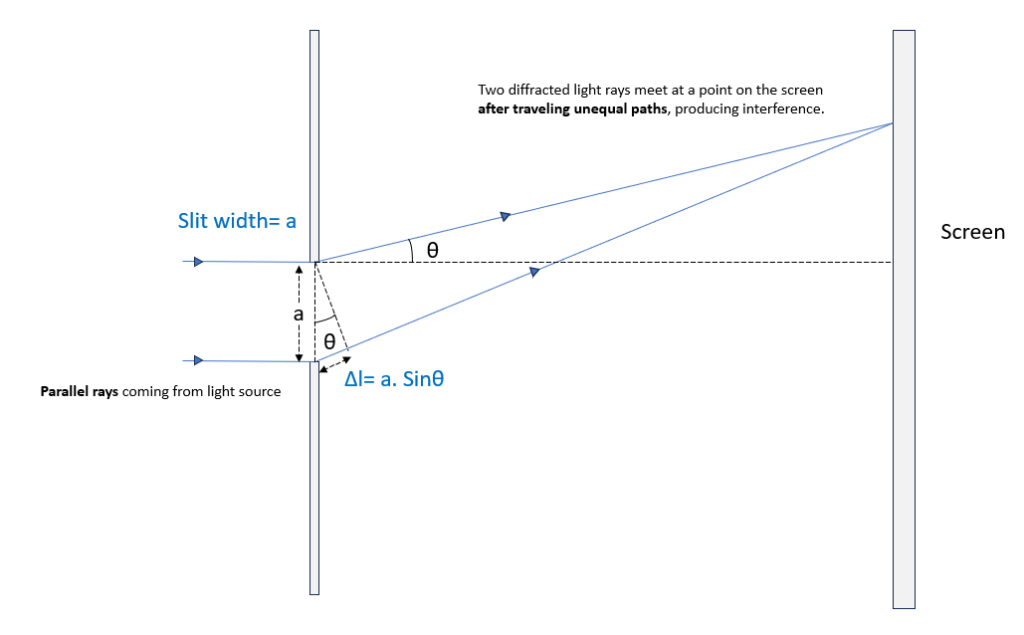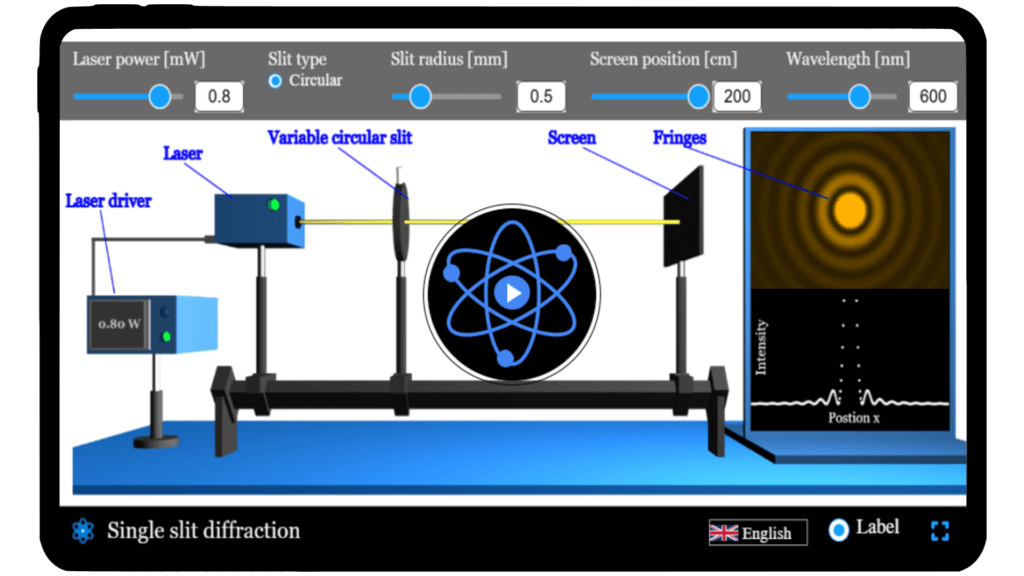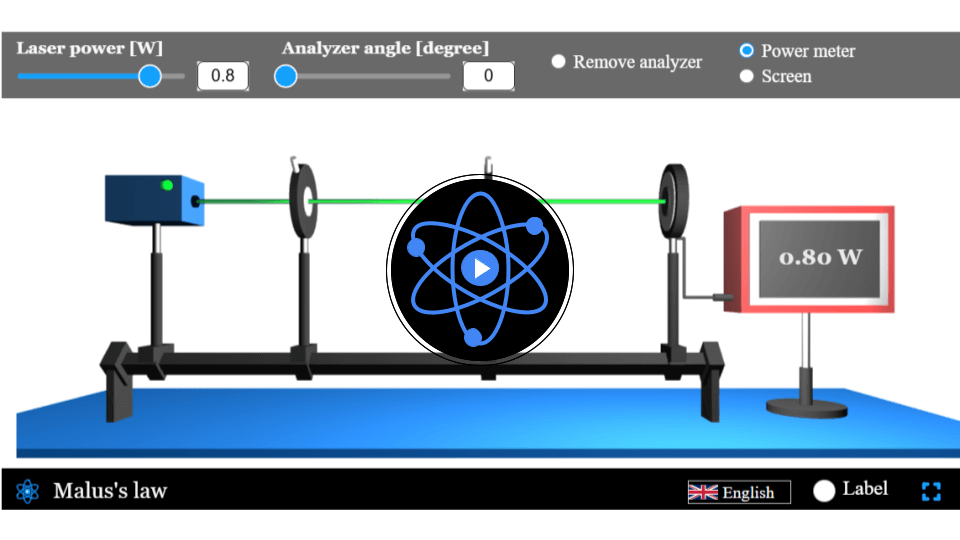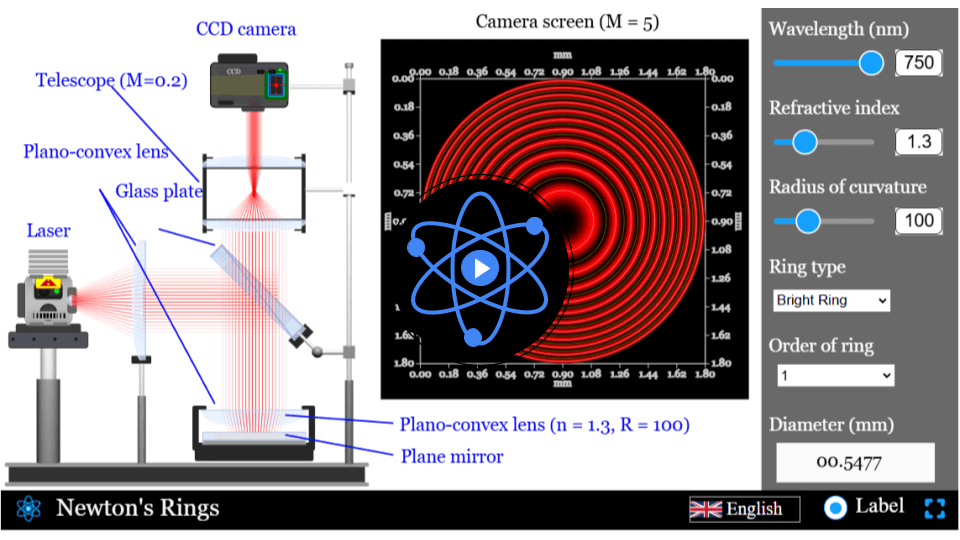Single slit diffraction simulator
Explore the fascinating wave behavior with our single slit diffraction simulator, and observe how light spreads and forms an interference pattern as it passes through a narrow slit.
Single slit diffraction
Few discoveries in physics have impacted our understanding as deeply as the phenomenon of single-slit diffraction. This experiment provided compelling evidence for the wave nature of light, reshaping the way we see the physical world. Now, through our interactive simulator, you can explore this fascinating phenomenon yourself. Adjust variables, test different conditions, and watch as the dark and bright fringes of single-slit diffraction come to life. Dive into the science behind light’s behavior and start experimenting today!
\( a \sin \theta = m\lambda \),
Mathematical description
where:
- \( a \) is the width of the slit
- \( \theta \) is the angle of diffraction
- \( \lambda \) is the wavelength of light
- \( m \) is the order of dark fringe (\( m \) is an integer)
Tutorial video
Take a quick spin through our simulator!
Simulator
Dive into the physics of light diffraction with our interactive Single slit diffraction simulator!
Interactive Physics Simulator – Diffraction (Single Slit)
🌟 You May Also Like
Suggested experiments and activities based on your progress...
FAQs on Single-slit diffraction
Qus 1. What is Single-Slit Diffraction?
Single-slit diffraction is a phenomenon where light passing through a narrow slit spreads out and creates a pattern of alternating dark and bright bands on a screen. This occurs due to the wave nature of light, as waves interfere constructively and destructively, creating these patterns.
Qus 2. How does single-slit diffraction work?
In single-slit diffraction, light waves passing through a narrow slit interfere with each other. The central maximum is brightest and widest, while subsequent bright and dark fringes are formed due to constructive and destructive interference, respectively. The pattern’s width depends on the slit width and wavelength.
Qus 3. What is the difference between single-slit and double-slit diffraction?
In single-slit diffraction, light spreads from one slit, producing a central maximum with smaller side maxima. Double-slit diffraction, however, produces multiple bright and dark fringes due to light interference from two slits. Double-slit patterns have sharper, more regularly spaced fringes.
Qus 4. What is the formula for single-slit diffraction?

The formula that predicts the position of the dark fringes in single-slit diffraction pattern is \( a \sin \theta = m\lambda \), where:
- \( a \) is the width of the slit
- \( \theta \) is the angle of diffraction
- \( \lambda \) is the wavelength of light
- \( m \) is the order of dark fringe (\( m \) is an integer)
Qus 5. What is the central maximum in single-slit diffraction?
The central maximum is the brightest and widest part of the single-slit diffraction pattern. It occurs at the center of the screen and is flanked by dark and bright fringes. The central maximum is brighter because most light waves constructively interfere at this point.
Qus 6. How does wavelength affect single slit diffraction ?
Wavelength plays a crucial role in shaping diffraction patterns. Longer wavelengths, like red light, produce wider diffraction patterns, while shorter wavelengths, like blue light, create narrower ones. This occurs because longer wavelengths lead to more pronounced diffraction, bending and spreading more noticeably as they pass through small openings.
Wave Bending and Spread:
When waves pass through an obstacle or narrow opening, they bend and spread. This effect is more visible with longer wavelengths relative to the opening size. If the wavelength is much smaller, the wave moves with minimal bending, reducing the visible diffraction effect.
Interference Patterns:
Diffraction patterns arise from waves interfering after bending around edges. For significant diffraction, the wavelength should be similar to the pattern spacing. Longer wavelengths create broader, more visible fringes, while shorter wavelengths lead to finer, harder-to-detect patterns.
Qus 7. What are the applications of single-slit diffraction?
Single-slit diffraction is used in optical instruments and spectroscopy to analyze light. It also explains certain natural patterns, like light diffraction in small apertures. In science, it helps understand wave properties of light, essential in fields like quantum mechanics and material analysis.
Qus 8. Why is single-slit diffraction important in physics?
Single-slit diffraction demonstrates the wave nature of light and helps explain interference and diffraction, fundamental concepts in physics. It provides insights into wave behavior, influencing fields like optics, quantum mechanics, and photonics, and is essential for developing optical instruments.
Qus 9. How is single-slit diffraction pattern formed?
A single-slit diffraction pattern forms when light passing through a narrow slit spreads out and interferes with itself. This creates a central bright maximum, surrounded by alternating dark and bright bands due to constructive and destructive interference.
Qus 10. How does slit width affect single-slit diffraction?
The width of the slit impacts the diffraction pattern’s spread. A narrower slit causes the light to spread more, creating a wider diffraction pattern. Conversely, a wider slit limits diffraction, resulting in a narrower central maximum and more closely spaced fringes.





Hi, I do think this is an excellent website. I stumbledupon it 😉 I am going to return yet again since I bookmarked it.